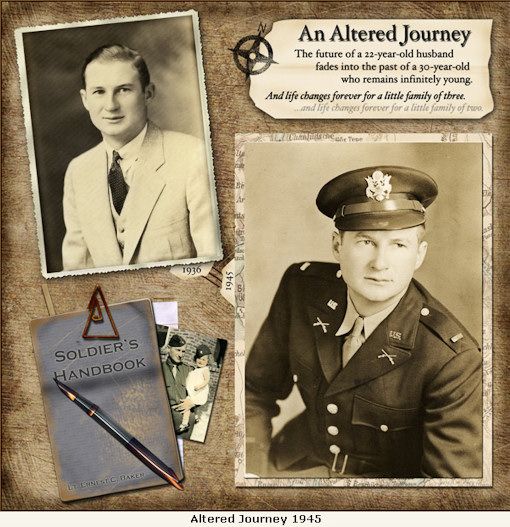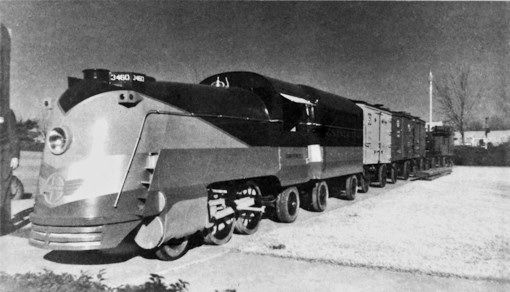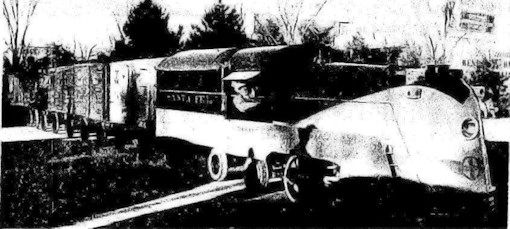Last Updated: January 3, 2011
Now Includes 5 Vignettes
The Latest is from Judy Baker Riley
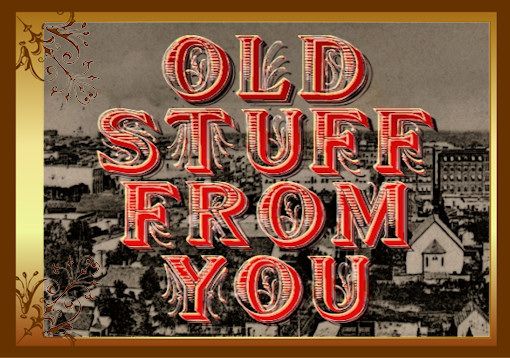
From time to time, I've been privileged to receive e-mails or correspondence from blog readers who volunteer very interesting information, photos, or postcards which give a glimpse into the lives of their ancestors who lived in Oklahoma City a very long time ago. Sometimes, such contributions have been massive (Norman Thompson's and Dean Schirf's stuff comes to mind) and I've done full or multiple articles based upon their input. But, until this morning, I'd not decided how to incorporate contributions which are more akin to vignettes although I've always intended to do so. But, now I know what to do (or at least think that I do) — create a running article which will be expanded over time as new brief reader-supplied contributions are made about their ancestors in early day Oklahoma City.
This article will grow over time to include vignettes, small stories, and/or vintage graphics that you, the readers, volunteer from the legacy of your own families which give interesting glimpses into our common past.
I've organized this post to place contributions in reverse chronological order so that the newest item is always at the top, and the oldest is always at the bottom.
So, let's get started.
#3 Ron Kiser on Street Trains #4 Doug Hamilton on Boston Bloomer Girls
#5 Judy Baker Riley on Her Okc Roots
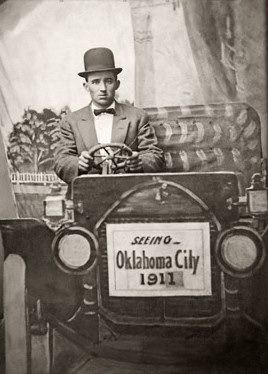 #5. Judy Baker Riley On Her Oklahoma City Roots. Judy, gone from Oklahoma City since 1966 and now living in California, presents a very charming and poignant way for the 2011 New Year to begin. Although her story developed less chronologically than this vignette article suggests, I've rearranged some of its parts to give more of a chronological progression. But, I'll begin in the middle, as Judy did when she emailed me on August 28, 2010. She said,
#5. Judy Baker Riley On Her Oklahoma City Roots. Judy, gone from Oklahoma City since 1966 and now living in California, presents a very charming and poignant way for the 2011 New Year to begin. Although her story developed less chronologically than this vignette article suggests, I've rearranged some of its parts to give more of a chronological progression. But, I'll begin in the middle, as Judy did when she emailed me on August 28, 2010. She said,I grew up in Oklahoma City but haven't lived in Oklahoma in many years. * * * The attached group picture includes my grandfather, Ernest Clinton Baker, Sr., who is on the bottom right. He died in 1934 at the age of 45, so I think this photo would be dated within a few years before that. On the back of the photo my grandmother had written "John A. Brown," but I believe he worked for a public agency (perhaps Oklahoma County) and not the department store. Since so few pictures of him exist, I assume she had prints made through Brown's.
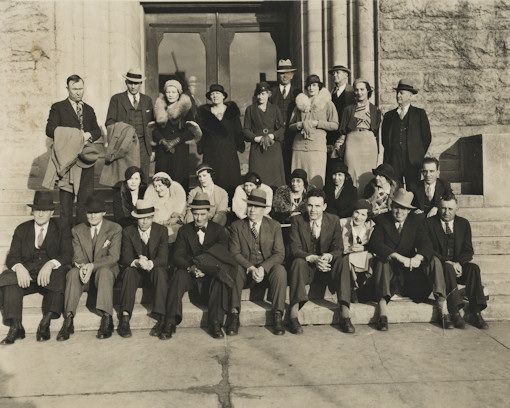
Judy's quest was to identify the building in the background of the above photo, probably taken in 1932 or 1933, and in the process she has provided us with one of if not the most exacting view of an entrance to the old Oklahoma County Courthouse at 520 West Main (Main & Dewey) that can be found. In looking at some of the Famous Kiltie Band photos which were known to have been taken at the old Oklahoma County Courthouse in 1925, it became evident that the background for this amazingly sharp photo was, in fact, that same building.
About the photograph, Judy said, "Wouldn't it be fantastic if other readers see their relatives in that group photo?" Click on the above image for a very clear view of the faces and perhaps you will.
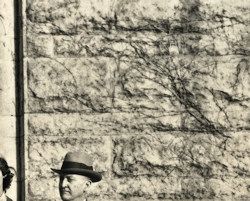 See the original Kiltie image kindly furnished by Sheila Johnson in 2008 and you will recognize the steps and the faux columns flanking the entrance even though through a fish-eye lens. Although the Kiltie images show exterior walls being rather fully covered with ivy, this higher resolution cropped view of the upper right area of Judy's photo clearly shows remnant traces of the old ivy. Click on the image for a larger view.
See the original Kiltie image kindly furnished by Sheila Johnson in 2008 and you will recognize the steps and the faux columns flanking the entrance even though through a fish-eye lens. Although the Kiltie images show exterior walls being rather fully covered with ivy, this higher resolution cropped view of the upper right area of Judy's photo clearly shows remnant traces of the old ivy. Click on the image for a larger view.A March 30, 1932, Oklahoman article showed that her grandfather was a deputy country treasurer at that time and earned the whopping salary of $130 per month — in 1932, that was not necessarily chump change since the County Treasurer's monthly salary was $333.33. In any event, problem solved — the background building was clearly the old Oklahoma County Courthouse, and those in the photo were probably deputies who worked in the treasurer's organization in 1932. Those named in the Oklahoman article were E.J. McBride, probably chief deputy (judging by his monthly $190 salary — all others' monthly pay was between $150 to $100), and Birdie Bickel, Frances Von Elm, Josephine Ryan, Myrtle Patterson, Virginia Jacobs, Georgia McDonald, Wayne Clegern, C.B. Jones, Lee Martindale, Helen Key Nye, Pat Childres, Rodney Cox, J.A. Kirchmeler, Avon Gale, J.A. Southern, L.L.Milner, J.D. Pinkerton, Frances Oliver, Bob Odom, Gertrude Meeker, C.B. Thompson, E. Riddle, T.C. Anderson, Margaret Gosvner, Mayme Moffett, Ross H. Routh, Ruth Ranking, Elizabeth Adams, Ola Holloway, Ben Rhodes, and, of course, Ernest Baker.
But, is that all that there is to this story? No, not at all.
Judy maintains an absolutely charming, and I would say stunning, scrapbook album/journal at this address although you may find it more convenient to enter her scrapbook pages here. Amongst those pages, she says,
Many of these layouts are about a small Oklahoma town located on Route 66. My father's maternal grandparents, who both lived into my adulthood, were pioneers of the area after Grandpa, his brothers and his brothers-in-law made the Land Run to claim 160 acre homesteads.
As the first great-grandchild, I was able to spend many days and weekends with my "Greats" in Arcadia (formerly Deep Fork Township, Oklahoma Territory). My happiest childhood hours were spent in this small town. I was the constant companion of my beloved Grandpa, and I will truly miss him for the rest of my life.
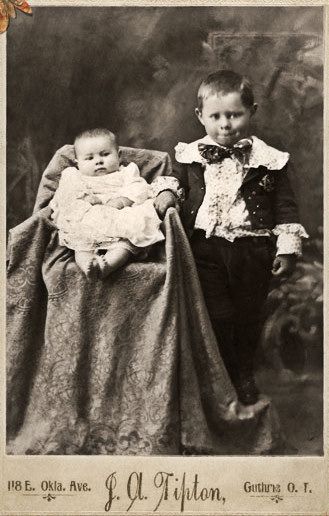 From Judy's scrapbook web pages, some enchanting images of her family's history are shown. Let's begin with Judy's grandmother Gertrude Sweat in 1897 with this photo (right) doubtless taken while she lived in Arcadia. Notice that the photographer was located in Guthrie — I haven't checked to be sure, but Guthrie was probably closer to Arcadia than Oklahoma City was even though the more populous cities were located in different counties — that would account for the fact that a Guthrie photographer took the photograph.
From Judy's scrapbook web pages, some enchanting images of her family's history are shown. Let's begin with Judy's grandmother Gertrude Sweat in 1897 with this photo (right) doubtless taken while she lived in Arcadia. Notice that the photographer was located in Guthrie — I haven't checked to be sure, but Guthrie was probably closer to Arcadia than Oklahoma City was even though the more populous cities were located in different counties — that would account for the fact that a Guthrie photographer took the photograph.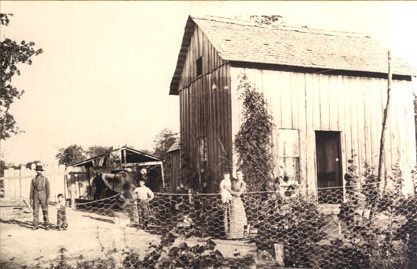 About the 1897 photo at left, Judy said, "My grandmother was born on a 160-acre homestead in Indian/Oklahoma Territory in 1897. Although most of her life was lived in towns and cities, she remained a true pioneer woman throughout her long life. In this photo [left], infant Grand Bake is in her mother’s arms; her father and brother are on the left; and the family’s very young hired hand, Alan Bates, is in the center."
About the 1897 photo at left, Judy said, "My grandmother was born on a 160-acre homestead in Indian/Oklahoma Territory in 1897. Although most of her life was lived in towns and cities, she remained a true pioneer woman throughout her long life. In this photo [left], infant Grand Bake is in her mother’s arms; her father and brother are on the left; and the family’s very young hired hand, Alan Bates, is in the center."Elsewhere in her scrapbook pages, Judy continues her description:
After the railroad crossed Indian Territory in the 1870s [ed. note: if she means the Santa Fe railroad, the date would be 1886-87], the government was put under great pressure to open lands to the white settlers who were flocking to the area. On April 22, 1889, eager settlers lined up on horseback and in wagons awaiting the pistol shot that would start the First Great Oklahoma Land Run. Among those German immigrants who raced to fulfill their dreams of owning land were my dearly beloved great grandfather, his brothers, and his brothers-in-law.About that last statement, Judy is not alone. My wife, for example, has recounted to me many times that her father, of mixed white-Native American ancestry, and an oil field worker in the Seminole County and southern Kansas oil fields in the 1920s-1930s, was anything but proud of his Native American heritage — so much so that he never spoke of it and refused to discuss it with his two children, my wife and her brother. After his death, and on account of that refusal, it took my wife and her brother a considerable amount of research to identify that part of their origins which were and are Native American and about which they are very proud.
Although this young family would later move to Deep Fork Township to become merchants, my Grand Bake’s heart was always with this homestead. I spent many happy childhood days on this land with my grandmother and her parents. It would be many years before I matured enough to question why I waited too late to ask my sweet, gentle, little Cherokee great-grandmother for her family’s story.
 But back to Judy's story. The photo at left shows her grandfather in a photo taken at the State Fair of Oklahoma in 1911 via a photographer's scene which made it appear as if one was actually driving an automobile.
But back to Judy's story. The photo at left shows her grandfather in a photo taken at the State Fair of Oklahoma in 1911 via a photographer's scene which made it appear as if one was actually driving an automobile.That image is followed by a 1913 photo showing Judy's grandparents, shown below. Click on the photo for a larger view.
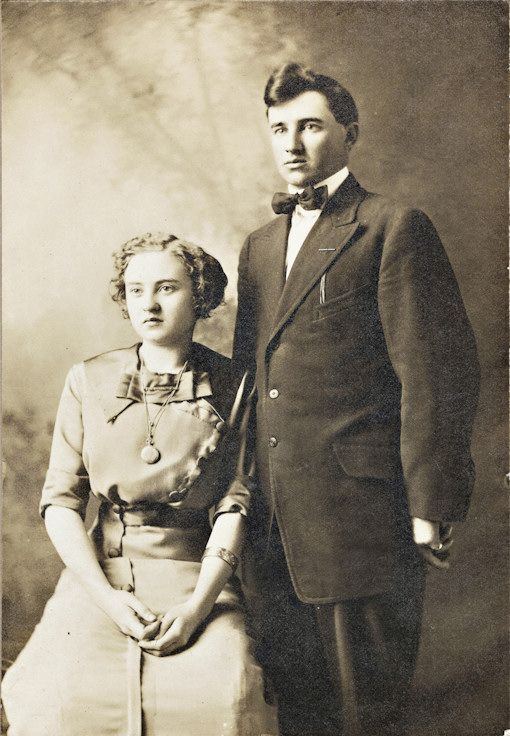
About them, in an email message, Judy said,
Ernest Clinton Baker (1888-1934) was born in Kansas and died in Ardmore, OK, while on a business trip. His parents were Clinton Albertus (Al) and Mary Ellen (White) Baker who raised their very large family mostly in central Oklahoma. The majority of siblings lived in the OKC and Edmond areas, I believe. The oldest child John Rex Baker (1884-1943) may have been president of the Stockyards at one time, but I don't know for sure — I just remember hearing things in the family.As for Judy, she is a daughter of Ernest Clinton Baker, Jr., a son of Ernest Clinton Baker, Sr. An April 14, 1943, Oklahoman birth notice reported that, "Judith Ann Is Name of Bakers' Daughter. Judith Ann is the name chosen by Lieut. and Mrs. Ernest C. Baker, 1517 Northwest Twenty-fourth street, for their daughter born Sunday at St. Anthony hospital. Lieutenant Baker is now stationed at Fort McClelland, Ala."
Ernest married Gertrude Matilda Sweat (1897-1992) on 07 Jan 1913 in Arcadia, OK.
Gertrude was born on a homestead near Tohee, OT, and her family later moved to Deep Fork Township (now Arcadia) where her parents ran a butcher shop and undertaking parlor. (I always found that to be an interesting combination! The businesses were separated by a wall, at least.) Her parents were Russell Abraham and Margareta (Gertie) Mihram Sweat who lived into my adulthood and stayed in Arcadia for their entire lives. Their store/home was about a block down the street from the Round Barn on Route 66. After their wooden building was razed, Grandma lived in the old bank next door — always loved the walk-in safe that graced her living room.
I said to Judy, "I'm figuring that the article was about you. I looked up 1517 NW 24th at the County Assessor's website but the address didn't return anything ... the home no longer exists. Google maps shows it as part of a parking lot on the OCU campus."
But deja vu all over again! I said to Judy, "Anyway, it's possible, even if not probable, that you and I (at least our moms) once shared the same room at St. Anthony's but at slightly different times ... I was born there July 2, 1943." To that, she replied, "Not only would we have been St. Anthony 'roommates' but we probably saw the first light of day in the same delivery room." It's a small world. Judy was graduated from Northwest Classen High School in 1961, I at Lawton High School in the same year.
Judy provided other information about her family — or else I got it from her own website scrapbook albums.
After Gertrude was widowed at a relatively young age, she supported her two sons by going to work. She worked for the Oklahoma Highway Patrol for many years. After retirement, she learned to drive for the first time at the age of 67 — and terrorized the streets of OKC! She, too, lived a long and healthy life and was able to be good friends with her adult great-grandchildren. Those pioneer girls were tough.You will notice a small inset of a photo next to the Soldier's Handbook.
Ernest and Gertrude's two sons were my father Ernest C. (Bill) Baker worked at the Stockyards until he enlisted [shown below - click image for larger]. As an Infantry Lt., he was killed following the Battle of the Bulge.
My Uncle R. A. Baker was a Marine in the Pacific Theater. After leaving the military about 1947, he helped manage Triple AAA Root Beer until his too early death in 1972. Some of your readers may remember him since he was also very involved with the Shriners — and they'll surely remember his father-in-law's root beer company and that giant root beer barrel at the corner of ... Broadway & Main? ... for so many years. [Ed. Note: It was Broadway & NW 13th.]
Here's a larger view of that poignant image which possibly shows the last physical contact between father & daughter before his death in World War II. This photo was taken in 1944 and may depict one of the the last times that Judy was held in her father's arms. Click the image for a larger view.
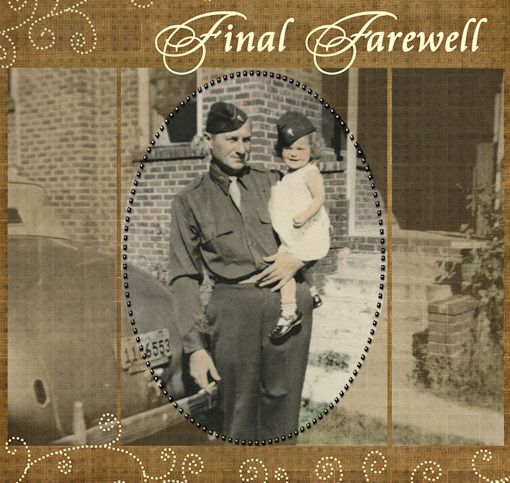
Probably most of us who are in Judy's and my age group (we were both born in 1943) experienced the sudden void of a loved one during the World War II time frame. For Judy, it was her father. For me, it was my mother's brother, an uncle that I'm named for but never met. The preliminary list reported in a July 1,1946, Oklahoman, article identified the names of 5,474 Oklahomans who either died or were listed as missing in action during the war. Included in that list from Oklahoma County was Judy's father.
But, of course, life did go on for the living. In this context, perhaps the best of the images in her scrapbook web pages is of Judy herself. Who can possibly look better than a bride in vibrant bridal regalia? The image below shows her decked out in 1964 at age 21.
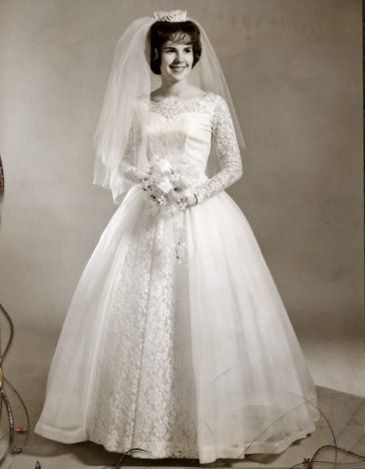
This brings this vignette to a close — but not necessarily to its final resting place. Judy also has a keen interest in those affected by the Great Depression and Dust Bowl period who were impoverished and living in the city, many along the banks of the North Canadian River near May Avenue.
That topic will be visited in the future, as will her reference the AAA root beer icon in the city which was located on the northeast corner of Broadway and Northwest 13th — a topic that has been on my back burner of things to do for many months.
She also wanted me to pass along a few sources that may be useful in some readers' searches of their own:
I've been working on family history and wonder if you've ever done a story on the Mays Avenue Camp? (Apologies if I've already sent this — haven't been very good about crossing off my to-do list.) I drove over that May Avenue Bridge most of my early life and never knew the history of the shanty town beneath it.Thank you Judy Baker Riley for your outstanding contribution! You done good!
I imagine you already know that it was established for the starving families of farmers during the Dust Bowl, but I never heard that story. My mother was from a poor family and she was part of that migration of temporary workers to California when she was a teenager — it wasn't a time she liked to talk about.
Anyway, just in case no one has called these photos to your attention, try this link for my search for Mays Avenue Camp photos in the Library of Congress. If it doesn't work, use the Library of Congress Farm Security Administration link and search for "Mays Avenue camp."
On a completely different note, I've also started researching my father who was killed in Germany in the months following the Battle of the Bulge. My mother's grief basically guided the rest of her life so I don't have much information that is truly factual. His records were completely destroyed in the 1973 fire, but I've been getting some amazing documentation from military historians on WWII forums.
One man sent the daily report/journal (?) from his father's tank battalion that was supporting my father's infantry unit at the time of his death — the man even told me which day he thought my dad died (he was right). Some fascinating stuff and some incredibly kind people out there. If you or any of your fellow local historians get requests for help from people researching veterans whose records were in St. Louis, please tell them to search military history forums — found a gold mine.
And two more resources I've found recently (which may be old hat to you). They aren't related to OKC but I know you have friends who might be interested. I was lucky enough to find 700 pages (so far) of detailed court records (interviews, witness testimony) for a 20-year lawsuit between my husband's Dawson family and The Cherokee Nation. It ran from about 1882-1904 and the transcripts record dialogue in which people are asked for maiden names of mothers and grandmothers, about family migration patterns, etc. Those were in the Dawes Packets on (premium) Footnote.com.
Also for my husband's Dawson family (and he has YET to understand the value of all this!), I was lucky enough to discover a Vinita, IT, newspaper called the Indian Chieftain at Chronicling America: Historic American Newspapers. It's also full of articles about his family.
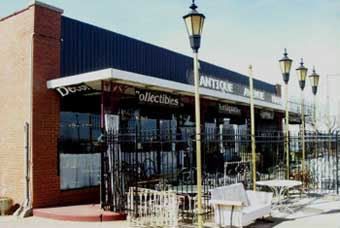 #4. Contributed By Doug Hamilton, Oklahoma City. On December 8, 2010, I received a call from Doug Hamilton, lawyer, friend, and proprietor of a quality stall at the Antique Avenue Market located at 5219 N. Western, Oklahoma City. Thorough readers of Doug Dawgz Blog will perhaps remember that I have gotten some very nice pieces from his shop — several maps (including a 1911 Oklahoma City Planning Map, the Manley's Oklahoma City map circa late 1930s-early 1940s, and the 1957 Adams Map of Oklahoma City); a very neat little book, The Life of a Successful Bank, 1908-1978, the story of Fidelity Bank, and another book which is considerably more important but which sat on my bookshelf for a couple of years before I opened the cover — The Oklahoma Land Rush of 1889 by Stan Hoig which is one of the primary sources for Maps & History of Oklahoma County 1830-1900, Part 1 and same name, Part 2. As well, I obtained my copies of the uniquely important three-part Vanished Splendor books from Doug, as well as some other things.
#4. Contributed By Doug Hamilton, Oklahoma City. On December 8, 2010, I received a call from Doug Hamilton, lawyer, friend, and proprietor of a quality stall at the Antique Avenue Market located at 5219 N. Western, Oklahoma City. Thorough readers of Doug Dawgz Blog will perhaps remember that I have gotten some very nice pieces from his shop — several maps (including a 1911 Oklahoma City Planning Map, the Manley's Oklahoma City map circa late 1930s-early 1940s, and the 1957 Adams Map of Oklahoma City); a very neat little book, The Life of a Successful Bank, 1908-1978, the story of Fidelity Bank, and another book which is considerably more important but which sat on my bookshelf for a couple of years before I opened the cover — The Oklahoma Land Rush of 1889 by Stan Hoig which is one of the primary sources for Maps & History of Oklahoma County 1830-1900, Part 1 and same name, Part 2. As well, I obtained my copies of the uniquely important three-part Vanished Splendor books from Doug, as well as some other things.  Doug is relocating his shop to the Ancient of Days Mall at 5129 N. Western on January 1, 2011.
Doug is relocating his shop to the Ancient of Days Mall at 5129 N. Western on January 1, 2011.In the December 8 telephone call, Doug wondered if I knew anything about the "Boston Bloomer Girls," and, more particularly, their appearance at Delmar Garden on or about June 12, 1910. In 1910, the city's main base ball park was located in the center of the horse race track at Colcord Park, located within Delmar Garden — see Oklahoma City Baseball, Part 1. But, beyond that, I knew nothing. Doug said that he had acquired a remarkable postcard which placed that girls baseball team at Delmar Garden in June 1910, and that it might just be the finest Oklahoma City postcard that he had come by.
Doug also sells stuff on Ebay and that was his plan for marketing this particular postcard. He said that he might be overly proud of this postcard but his doubt proved unfounded since it sold for $299.99. Before the sale, Doug kindly scanned and e-mailed me the postcard, shown below, and consented that I post the images here. Click on images for a larger view, particularly the front-side, which is quite remarkable and which probably appears nowhere else on the internet other than here — certainly not in the resolution shown when clicking on the principal image, below.
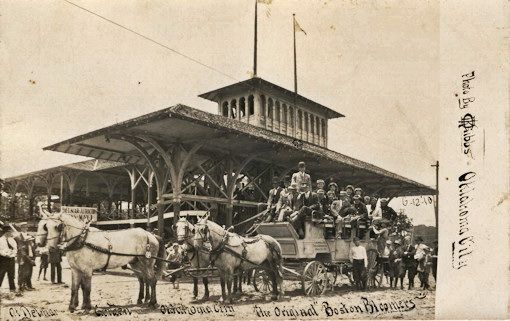

Further research showed that the Boston Bloomer Girls was a ladies baseball team that toured extensively in the first two or three decades of the 1900s, particularly in the midwest. Archived Oklahoman articles showed a heavy presence of the team in Oklahoma during the years around 1908-1912 or so.
The "best" find in the Oklahoman archives was the photo/caption image shown below in the June 12, 1910, Oklahoman (which matches the date appearing on the postcard):
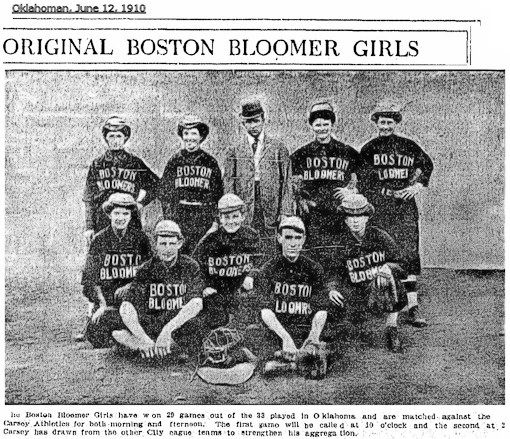
#3. Contributed By Ron Kiser, Oklahoma City -- the Santa Fe Parade Train. In a November 22, 2010, e-mail, Ron Kiser presented the following fascinating photos that I've not seen before, as well as questions that I could not answer. He said:
I am attaching two pictures that have the main focus of the Santa Fe Railway's "parade" train. I have found quite a bit of info about the rubber-tired train, but I am curious about other items in the pictures.I couldn't help Ron with his questions, but perhaps you other readers can.
The pictures were taken in front of the Municipal Auditorium. The pictures were processed by Kodak on January 6th, 1947.
Specific questions:Any help you can give me would be appreciated.
- Why was OKLAHOMA in block letters on the top of the auditorium?
- What is the tall, slim tower behind the rear car of the train?
- What is the building directly behind the caboose of the train?
December 8, 2010, Update: I shared the above photos with my OKC history friends in RetroMetro OKC at its December 6, 2010, meeting & social event, particularly with Dean Schirf my good friend and railroad buff, but also with several others. It was master-researcher Larry (Buddy) Johnson, senior research librarian at downtown's Ronald J. Norick Library, that came up with some of the answers to Ron Kiser's questions. In an e-mail, Buddy wrote:The train was owned by Merle Benson, a Santa Fe employee from Topeka who built it in the road's Topeka shops. He operated the train at parades and fairs and let kids climb over it and play on it at "sidings" (as seen in [the] photo) when not in use. It was seven cars long and the loco was built over an automobile engine.
Benson brought his train to OKC to take part in the homecoming parade for Oklahoma! which made its state debut at Municipal Auditorium on November 26, 1946. All of downtown was decked out in pioneer paraphernalia, but alas a freezing rain struck the city and the parade was called off. Benson still parked his train in front of the auditorium for two days. I think that's when [the] photo was snapped.Using Buddy's leads, I researched a bit further in the Oklahoman's archives. Buddy was off by a day on the show's opening, it opening on Monday, November 25, the day scheduled for the parade, as shown by the November 25 ad at right. The November 25 Oklahoman reported that the 90-member cast and other support personnel arrived at the Santa Fe Station on the show's special train at 1:00 a.m. Monday morning and that a parade was scheduled for that day. The Tuesday, November 26 Oklahoman reported on the performance the evening before and that the November 25 parade had been canceled — for most — it also showed that one persevering group from the University of Oklahoma made its downtown presence known that afternoon notwithstanding the weather. A photo of the rubber-tire train was shown in the November 27 Oklahoman:
The caption under the above picture read, "Sidetracked — Flurries of winter may have stopped a parade and given a chill reception to Oklahoma City for theatrical bigwigs, but they didn't discourage Merle Benson of Topeka, Kan., from showing off his 100-foot 'toy' train. A Santa Fe display, the locomotive (built over an automobile engine) and seven cars have run between parades, fairs, and other celebrations for 20 years. Benson built the train in the Topeka shops, where he is a mechanic. It will 'sidetrack' at Municipal auditorium again Wednesday."
Those in attendance on opening night included Richard Rogers (music) and Oscar Hammerstein II (lyrics) and Lynn Riggs, author of the play, "Green Grow the Lilacs," on which the ballet-musical was based. Eight performances were had in the 6,000-seat municipal auditorium on Monday-Saturday with matinees on Wednesday and Saturday.
2. Brenda Lewis, from Texas, On Her Great Grandfather Capp Julius Jefferson. Brenda Lewis' story about her great grandfather, Capp Julius Jefferson, began in a couple of comments left in a couple of blog articles in 2009. In her first comment on August 29, 2009, in Deep Deuce History, she wrote, "Hey Deep Deuce. Sorry bout my post. I meant to say my great grandfather Capp Jefferson was in to buying property and into gas & oil leases, mineral rights. I have been tearing my hair out (ouch) looking for information on him. Thanks for your blog. Capp also was a member at mt Calvary [Baptist] for 40 years and that's where his funeral was held, November 2, 1946. Then, on August 30, 2009, she commented in the Ultimate Deep Deuce Collection, saying, "It's me again Doug Dawg. My grandfather Capp Jefferson moved to the 200 block of east first street after 1899 when he came to Oklahoma. Do you have anything on him? Anything will do and I can face bad things too. It would really be nice. Thank you if you can. Thank you if you can't. I realize you are a busy man."
When I initially looked in the Oklahoman's archives I couldn't find anything but the Oklahoman's search engines must have been down or failed because, when I looked last night, I found a bunch, and I'll add what I found after Brenda's story.
I invited her to write a biography about her great grandfather, to the extent that she knew it, and on January 6, 2010, she wrote in an e-mail to me and passed along the following photo and information:
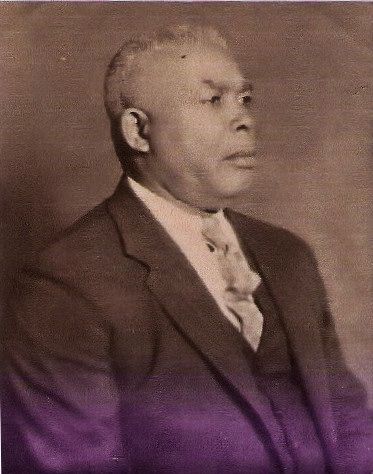
Update Note: On January 20, 2011, Brenda supplied an additional photo, this one of Capp & His daughters, below:
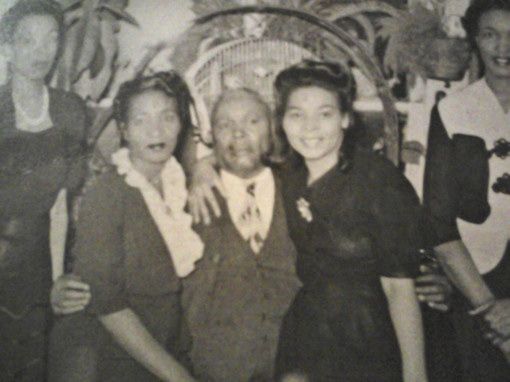
Brenda wrote:
First of all I would like to take this opportunity to thank Mr. Doug Dawg, for this wonderful blessing of placing my grandfather on his page. I begin looking into my family tree 8 months ago when Helen Bolin (my grandmother) begin coming to me in my dreams. So I looked on the internet for her name but found nothing. I called family members who told me to look up under her father's name: Capp Julius Jefferson. Well I found him on the internet stating he had written a eulogy for Booker T. Washington's funeral in 1915. I was throwed.Brenda said that the photo shown above was published in the "black newspaper," which would have then been the Black Dispatch, on the front page.
I continued to look and found he was born in Smithville, Texas on June 6, 1877. He came to Oklahoma City around 1899. He also lived in what I believe you call the Deuces, Doug. Around 1942 he moved to Detroit with his second wife and son Ralph. Capp Jefferson was sometimes called C.J or J.C. Jefferson and was a realtor and oil man. I don't believe he was licensed in anything he did but he went on to become a man of some wealth. I guess I say this because it was 1899 and blacks were not the most liked people in that day and age. As I looked on the Oklahoma County Clerk's site for land, Capp seemed to have done well. I saw where he had dealings with Dr. Slaughter, L.L. Land, Appleton, Inc, Jordan Petroleum Co., Phillips Petroleum, D. B. Ellis, F. E. Harper, J. Krouch, and Hall & Briscoe. He sold and brought land platted and un-platted with many people as well as with his own children: My grandmother Helen Jefferson Bolin who was the oldest, his other children Ruth, Orlanda, Hazel, Seloucta, son Branch. Their mother 's name was Sedelia Craig Jefferson who later divorced Capp Jefferson and he married his second wife Penny Marie Roebuck who had children at the time of their marriage: Samuel & Gershone Roebuck, and Florence Roebuck Johnson.
Capp Jefferson also ran for a Republican office and lost.
Capp died at the University Hospital in Oklahoma City on October 29, 1946. He attended Mt. Calvary Church [Calvary Baptist Church] for 45 years. He died from diabetes which runs in my family on both sides. He also owned most of Jefferson Ridge.
I don't know too much about my great grandfather except he liked to write poems. You can find two on the internet and there are several family members who like to write poems, too. In the Oklahoman newspaper it said at the time of Capp's death he had 4 farms and was in a major oil deal which would have netted over $50,000, yet no one in our family knows anything about this. Each of his family was to receive 1/11 of his estate. Well, you know you always have a greedy one in the midst but it has been a pleasure finding these things out about my great-grandfather Capp Jefferson.
My Own Oklahoman Archives Search. As I said above, I again looked through the Oklahoman's archives last night, and quite a bit of information was located. Links below are to copies of articles, many or all of which Brenda may not have seen before she reads this post. Some of the articles are less important than others, but to her they are probably all important since all relate to her great grandfather.
The first article was a May 9, 1906, snippet which reported that he and his wife had conveyed to Newton Avery for $1,300 Lots 27 and 28, Block 16, Military Addition on May 5, 1906; another snippet reported that a building permit was issued to him on April 4, 1912, for a lunch stand at 229 East First Street at a cost of $86; another that he a "Slaughter" leased Lot 11 of Block 22 of Military Addition on September 21, 1931 — the brief article does not say what the lease was for — quite possibly the "Slaughter" was Dr. Wyatt H. Slaughter discussed here. A May 8, 1933, article had to do with litigation in Common Pleas Court between Capp Jefferson and Dick Burgess and J.M. Gore — apparently, in oil and gas lawsuit it was shown that Jefferson had a written a note on a piece of pine wood that, "I will give two drillers $100 each to bring in a producer of at least 5,000 bbl. on this sit on or before Dec. 24th, 1930." The court found the side-note to be enforceable. A January 26, 1936, article having to do with the city's oil and gas zoning restrictions indicates that Capp Jefferson was also a lawyer – see the article here — but I found no other such reference in articles where such a reference would be expected to be repeated. A January 31, 1936, article, apparently relating to the topic just stated, referred to Jefferson as a "Negro impressario." The article quoted him as saying, "There'll be three kinds of people there," said Jefferson. "One kind will be the interests; another kind will be the folks that don't want oil extension, whatsoever; the last kind will be the folks with the public welfare at heart. That'll be me."
As Brenda said, Capp was also a 1937 candidate on the Republican ticket for an elective office. The November 21, 1937, Oklahoman, shows that the office which he sought was that party's nomination for the Oklahoma 5th Congressional District to the United States Congress. Of course, at the time, Republicans didn't hardly ever win anything in Oklahoma — in this race, official returns showed that 36,423 democrat voters voted, but that only 3,038 republicans did. Preliminary and incomplete returns on Wednesday after the election showed Jefferson in 3rd place of 5, but final returns on November 25 showed him as in last place — but, hey, he made the race and fought the good fight. Click here to see those articles. But, Brenda may not have known that he tried again to obtain the Republican nomination for the same office on two other occasions, in 1940 and 1942, but with the same results as the 1937 election. In each such election, he was the only black man or woman to run for either party's nomination.
A May 2, 1937, article evidenced his work in the Black community — in this instance, his involvement with a campaign to raise money for a Boy Scout program and to increase the library in the junior college branch of Douglass High School. The article noted that, "A feature of the campaign will be a contest to select Oklahoma City's most useful Negro citizen for 1937." The field of candidates was indeed full of stars from the Black community — Zelia Breaux and T.J. Randolph being two of the others. I was unable to discover the winner of that 1937 award.
His regard in the general Oklahoma City community was sufficient for him to be in an early batch of nominees for Oklahoma City's "Most Useful Citizen" in 1936 — the event was sponsored annually by the Oklahoman and the winner was chosen by a committee largely consisting of previous winners — see the December 13 article here. About him, the article says, "Capp Jefferson, Negro, for his letters to newspapers advocating racial tolerance." As of December 13, he was the only black person so nominated. By the time the nominations closed, the list had swollen to 68. Though Capp didn't win the award, it certainly says something that he was nominated, particularly during a time that racial tensions were still high because of Oklahoma City's Jim Crow laws.
In that regard, Jefferson was also indirectly involved. Generally, these local laws restricted black homes and businesses to a particular area and whites to another. This June 28, 1939, Oklahoman article reflects that, as an agent, he had sold a residential lot in a "white" area to a black owner, after his repeated attempts to lease the property to white tenants did not succeed. The property was bombed.
Although he was never elected to a public office, he remained politically active, as a March 19, 1943, Oklahoman article shows. In this instance, he was described as testifying before a state house oil and gas committee hearing dealing with oil and gas royalty owners and land owners on a measure then being considered in the Legislature. About his testimony, the article says, "Capp Jefferson, Negro realty dealer of Oklahoma City, termed the bill 'ambiguous, voluminous and obnoxious,' gained consent of the committee to present a new bill 'covering all the subjects' and not to contain more than 3,000 words." On another occasion, his opinion was quoted along with several others involved in the oil and gas industry concerning a pending oil and gas bill. The March 8, 1945, article said, "Capp Jefferson asked: 'Why did you put in there that this law is not subject to collateral attack? . . . Would you deny me the right of a trial by jury?' At another point, he asserted:'I'm for all the oil you can get as fast as you can get it.'"
Mr. Jefferson was involved in three decisions by the Oklahoma Supreme Court involving oil and gas or other business matters: Bonded Royalties Inc. v. Jefferson, 1935 OK 846, 50 P.2d 281, 174 Okla. 345, Jefferson v. British American Oil Producing Co., 1943 OK 411, 145 P.2d 387, 193 Okla. 599 (in this case, Mr. Jefferson represented himself), and Jefferson v. Burgess, 1935 OK 277, 42 P.2d 237, 171 Okla. 173.
My Oklahoman research winds down with a pair of articles describing the death of two prominent black Oklahoma City men. This March 10, 1945, article was the first. It honored the life of Jim Noble at his funeral service at Calvary Baptist Church, about equally attended, the article says, by whites and blacks. Two eulogies were delivered, one by the church's Pastor E.A. Keith, and the other by Capp Jefferson. The second article, on November 2, 1946, describes the life and death of Capp Jefferson himself.
Oh, I almost forgot, Brenda, and this might interest you. On February 14 and 21, 1993, the Oklahoma Tax Commission presented a huge list of those who had died but left unclaimed property in Oklahoma. Capp Jefferson's name was in the list.
1. Contributed by Ron Bodinson, Kansas City, Missouri. Actually, it was an email and then a regular mailing that served as the catalyst for creating this running-journal of brief but interesting things from readers wishing to share from the past of ancestors who lived here. He left a comment in this article saying, "I have three postcards of Oklahoma City from 1910 that I would be pleased to mail to Doug. Let me know," and I quickly took him up on his generous offer.
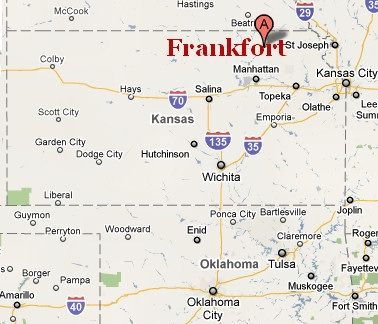 In sending the postcards shown below for my scanning (and for my return to him after that), he simply said, "My grandmother Lillian Chevry [sp?] saved these — cards to her mother; no credit necessary." (I'll certainly honor anyone's request to remain anonymous although it's much better in showing family history to use a real name instead of saying, for example, "a great grandson sent me the following..."). Each postcard contains a postmark and a brief note from either Lillian, Ron's grandmother, or from Walter [sp?], evidently Lillian's husband or brother (I'm sure that Ron will clarify after he reads this), to Lillian's mother, Mrs. E.N. Dotson, in Frankfort, Kansas.
In sending the postcards shown below for my scanning (and for my return to him after that), he simply said, "My grandmother Lillian Chevry [sp?] saved these — cards to her mother; no credit necessary." (I'll certainly honor anyone's request to remain anonymous although it's much better in showing family history to use a real name instead of saying, for example, "a great grandson sent me the following..."). Each postcard contains a postmark and a brief note from either Lillian, Ron's grandmother, or from Walter [sp?], evidently Lillian's husband or brother (I'm sure that Ron will clarify after he reads this), to Lillian's mother, Mrs. E.N. Dotson, in Frankfort, Kansas.Without more words, enjoy what Ron has contributed — click on any image for a 1024 pixel wide view.
Card 1 postmarked March 6, 1909. The front shows a panorama of Oklahoma City, shown below. Since the card was mailed early in 1909, it was presumably published in 1908 or very early 1909.
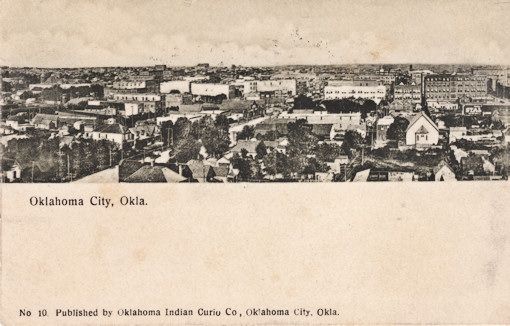
The backside shows that it was sent by Lillian, Ron's grandmother. I had trouble getting anything from the text but perhaps Ron will have some comments about that.
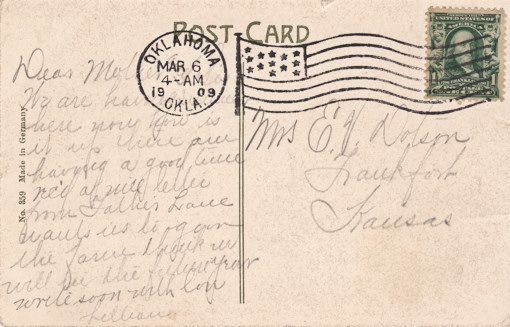
I'm rather certain that I've not seen this postcard before and the panoramic view may be unique. I've studied my scan of the cropped panorama itself trying to figure it out ... perhaps you will be identify what I so far have not ... for a 2400 px wide view of this image, click here ... for a 1024 px wide view, click the image below.
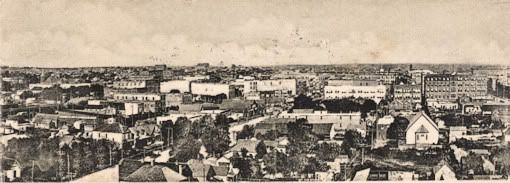
What is shown in this panorama? At first blush, I thought that the photograph may have been taken from Emerson School at N.W. 6th & Walker, looking east, and that the building faintly visible at the top right was the Lee-Huckins Hotel at Broadway & Main and that the larger building also far right but not at the edge was the Majestic Building located at the northwest corner of Main and Harvey, both of which existed by 1908-1909. But, that doesn't pan out. In the first place, Emerson School is and was too far north on Walker for the Majestic Building to have been seen at the angle presented in the photo; in the second, either from Emerson School or somewhere further south on Walker (or elsewhere), the vantage point looking east would have shown the the east/west Rock Island and Frisco railroad tracks which bisected downtown at the time (generally, running east and west between NW 1st & NW 3rd). Yes, there is a wide "space" at the right running "away" from the photographer which could theoretically be eastbound. But, no tracks are shown and many parallel tracks were present in the railroads' space. Last, occasional motor vehicles are seen in that space. The railroad companies' rights-of-way were not streets or used for automobile traffic.
After discarding the eastbound notion, I considered other options but came up empty. The most viable option seemed to be that the "space" was merely a "wide street," and, of course, only one such street was present — Broadway. Maybe the back of the church seen in the photo was the north side of St. Joseph's Catholic Church, which would mean that the photo was taken north of NW 4th Street looking south, with Broadway to the left. While that part may seem to fit, there are far too many "wide" (east/west) buildings shown in the photo. For the most part, buildings were "wide" or "long" on their north/south, not on their east/west sides. Strike two.
I'll study the image again later, but, thus far, that's all I've got to say about that. Feel free to comment if you think you've got the image figured out.
December 6, 2010, update on the above. I took printouts of the above image to a holiday meeting/party of RetroMetro OKC (the city's premier Oklahoma City history special interest group) this evening and passed it around. After it was closely studied by some of the most knowledgeable Oklahoma City history people that there are, the consensus — actually, the unanimous opinion — was that the photograph is not of Oklahoma City, notwithstanding the card's claim that it is. Early day postcard notations are well known to present either erroneous captions and/or images, and this postcard almost certainly is one such card.Card 2 postmarked March 15, 1910. This or similar postcards showing the view of Belle Isle Lake aren't uncommon but the color resolution and preservation of vibrant colors in this 100 year old card is quite remarkable.
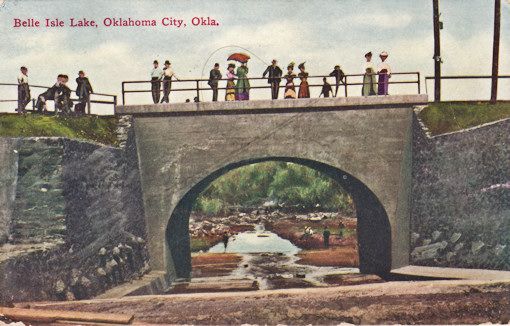
The back side shows this card was written by Walter [sp?] and that he had been having the "grip."
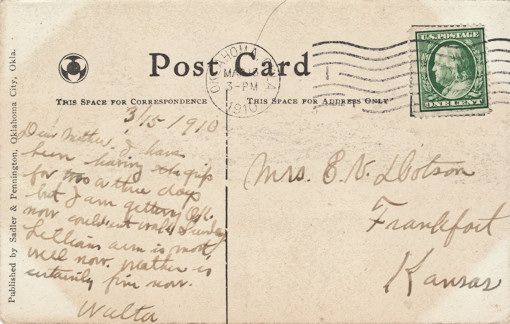
What the heck is the "grip?" Although I've heard the term before, I've not known what it means, and I'm still not exactly sure. You can read more of what the term meant in a pair of vintage New York Times articles: January 2, 1916 and March 26, 1900. Whatever it is or was, it apparently no longer exists — at least not by that name. But, then, it did, as is shown by Walter's [sp?] next postcard. [December 6, 2010, update about this card: see the useful comments about the "grip" or "grippe" in the comments pertaining to the same.]
Card 3 postmarked April 5, 1910. We've seen similar images of the Colcord Building (left) and Baum Building (right) being constructed at Robinson & Grand but I don't recall seeing one in which the Colcord Building was only up to its 4th or 5th story before. Two other buildings in the background are also being constructed — near background, State National Bank (to become the Hales Building), far background, Oklahoma City High School (to become Central High).
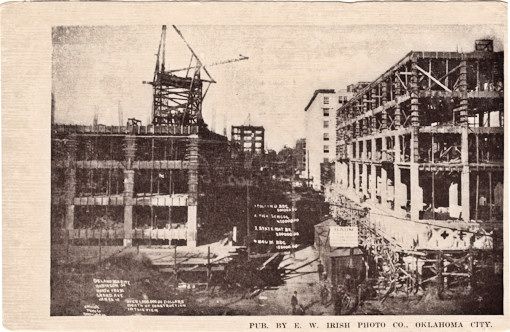
The back side shows that by now Lillian had the grip, also. The note also said that she was better and was "going downtown tomorrow." "These are some of the new buildings going up here *** very nice buildings."

Downtown pride was quite evidently present in 1910, just as it is today.
Thanks again for sharing, Ron!
More vignettes are yet to come. Some of you have much earlier sent me brief information and I've still got it somewhere and will try to get to it in the next few months — if I don't, nudge me with another e-mail to jog my memory. I would be pleased to have contributions from anyone that cares to make them. Click here and a page will open from which you can send me an e-mail, if you want.

